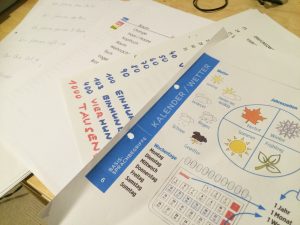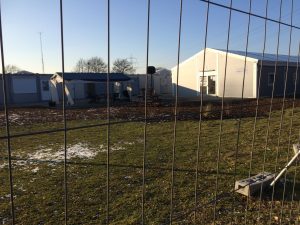New and interesting tasks
Because there is so much to do and see at my internship, within the past two weeks, I have been sent all over the city and have started participating in some of the many offerings of the German Red Cross in Duesseldorf. Within each of the shelters for asylum seekers that the GRC is responsible for in Duesseldorf, the atmosphere, needs and offered programs/services are very different. At the first shelter, I helped out and spent most of my time thus far at, I have been assisting the caseworkers during the busy and chaotic drop-in hours.But this past week, I was able to meet and tag along with some of the volunteers who provide some other services. For example, I helped out in one of the German language courses by going around and double-checking sentences and answering any questions, as well as handing out new study materials.

Some of the handouts from the German course that I assisted with
I was also able to sit in on an information session that a nurse for children and pregnant women held for a few pregnant women from Afghanistan. She then went upstairs, into a few other women’s rooms to talk and inquire more specifically about their younger children’s health and breastfeeding issues. I really enjoyed and treasured this experience because of how vulnerable, yet trusting these women were when they let us into their rooms, and they would treat us to Syrian coffee and tea and give us a comfortable place to sit while they would sit on the floor. Overall, two things that I have been realizing over and over again, is just how sweet, loving and similar these individuals are to me and that without the help of the volunteers at the shelters, things would be.. let’s just say, very different!
I was finally sent to another shelter this past week and it was much less “comfortable” than the first shelter I worked at. On the city of Duesseldorf’s site that lists all of the shelters and type of shelters, it lists this one as being made up of Leichtbauhalle (Lightweight construction halls) and to me, they looked kind of like big garages or large storage units. The electricity and heating is not as stable and insulated here and the bathrooms, kitchen and laundry facility are all located in separate buildings, which forces the residents to have to go out into the cold whenever these are needed. I and another new volunteer helped the one and only caseworker at this shelter with lots of accumulated paper work and other smaller, but time consuming tasks this week and it was clear that there is unfortunately just not enough time to do everything. But again, without extra help like this, the residents living in these shelters would be deprived of so many services and the caseworkers would be completely burnt out.

One of the “lightweight construction halls” at the second shelter
Every day at this internship is completely random, busy and chaotic. While this is sometimes stressful and overwhelming, I am really enjoying the fact that each day I am learning so much from the residents at the shelters, the volunteers who lead these necessary and extremely helpful services and of course, the caseworkers. There are still four other shelters for me to visit and lots of other programs to sit in on/ participate in, so I am looking forward to that! Thanks for reading!
Hi Cherice!
Loving your blog posts about your time in Germany thus far. I am working in Philanthropy & Alumni Engagement for the School of Social Work and wanted to introduce myself because we have not formally met. I would love to send you a few questions in regards to your experiences to use for National Social Work Month. If you are willing, you can reach me via email at jsbattis@buffalo.edu!
Enjoy the experience!
Hi Jennifer! I apologize for the slow reply! Thank you for commenting and for your excitement about my experience. I’d love to answer any questions you may have. I will email you shortly! Thanks again!
-Cherice
Thanks, Cherice, for sharing the details of your work in shelters and your impressions and feelings. And congrats on being able to help with the language lessons! A question: What determines which shelter a refugee goes to? Is the second shelter you describe used by adults only, so that children don’t face the necessity to travel outside to the bathroom building? Always interested in these policy decision!
Pat
Thanks Pat! Great questions. Each shelter is unique in many ways, but as far as demographics go, there are some shelters that mostly have families, mostly have single men and mostly have youth/ young adults. The shelter I mentioned is mostly comprised of single adult men but there are a few families who live there as well, and this is because space is limited. I also know that when they can, they try to group people together according to their country/ region of origin. For example, about 70% of the residents in one of the GRC’s shelters that I’ve visited come from Afghanistan and a shelter I went to today had the most residents from Russian speaking countries I’ve seen up until this point, but these individuals also live in other shelters. Overall, however, it depends on space and how urgently someone may need accommodation. I hope that answers your questions!